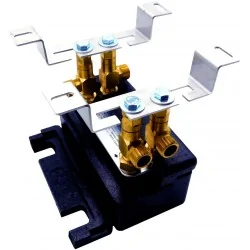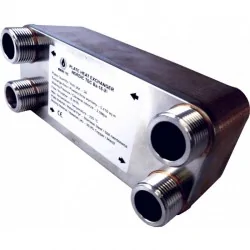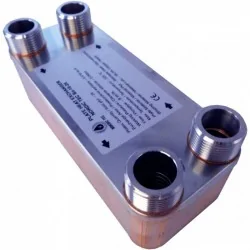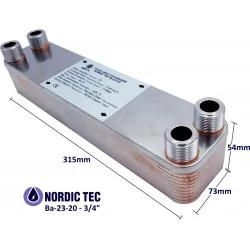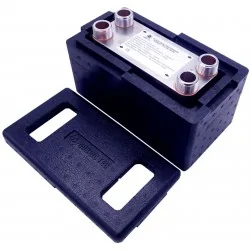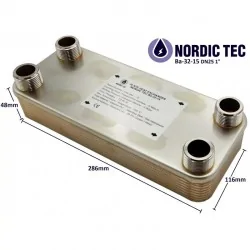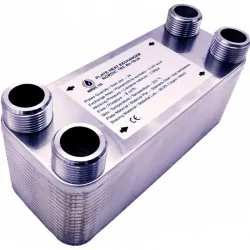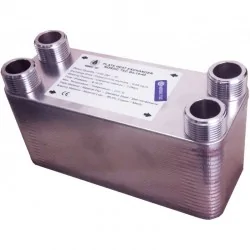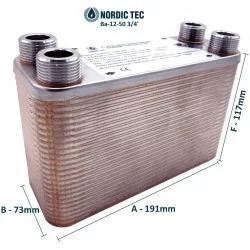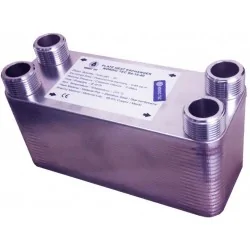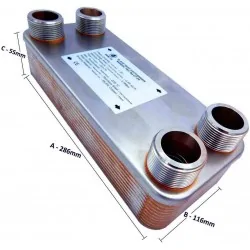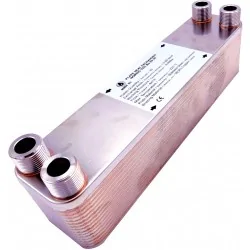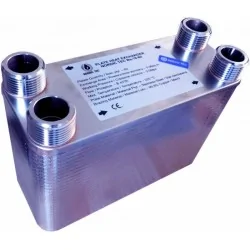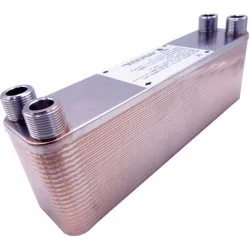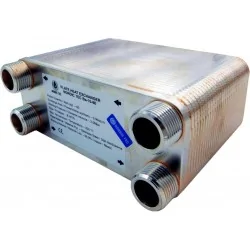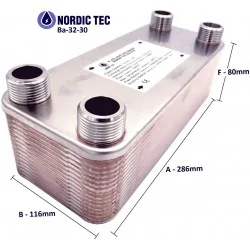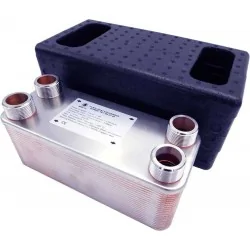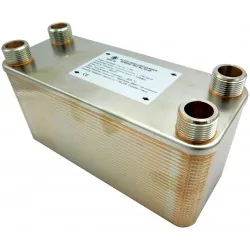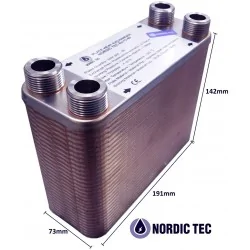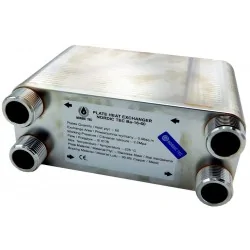Heat Exchangers for gas boilers
Plate heat exchangers for condensing - gas boilers
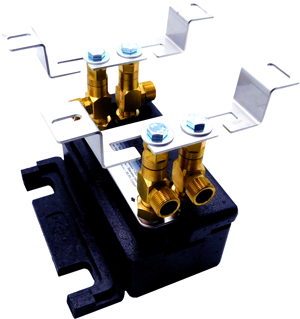
Below are PHE with optimal parameters for connecting gas boilers operating in a closed system with an open system installation.
How to size a plate heat exchanger for connecting a condensing boiler to a central heating system
In order to properly select - for every 10kW of a gas boiler, there should be at least 0.30m² of exchanger plate surface (heat transfer area). This calculator includes healthy oversizing, i.e. it allows effective heating also at low operating temperatures, in order to keep gas consumption low (condensation). With having 0.30m²/10kW, the exchanger should work efficiently also after many seasons (taking into account the partial aging of the device over the years). It should be definitely remembered when selecting that the nominal power of the exchanger does not correspond to the nominal power of the boiler. In the case of relatively new installations - you can safely use a smaller conversion factor, i.e. 0.25m²/10kW of a gas boiler.
Another selection factor is the size of the connections, but the exchanger should be selected in terms of cross-sections on the installation side, not on the boiler side. It is worth asking the installer about the size of the connections before ordering.
Below is a list of exchangers dedicated to gas furnaces - which you will find in this category:
| 0,36m² 0,38m² 0,41m² 0,46m² 0,48m² 0,48m² 0,51m² 0,54m² 0,60m² 0,64m² 0,64m² 0,69m² 0,80m² 0,92m² 0,96m² 0,96m² 1,28m² 1,60m² |
If you have a problem with the selection of a plate exchanger for a gas boiler - write to us 
Heat exchangers for gas heaters | Nordictec-store.com
Heat exchangers are among the most important components of gas boilers. The first one, made of steel, copper, or an aluminum-silicon alloy, is the flue gas - water heat exchanger responsible for extracting heat energy from the flue gases and transferring it to the heating system. The second one, known as the secondary water-water heat exchanger, is designed to connect gas boiler circuits with heating systems (underfloor heating, radiator heating circuits), and it is our company that deals with these secondary heat exchangers.
In the online store <Nordic Tec Europe> we offer high-quality plate heat exchangers for gas boilers. Our heat exchangers are made from the highest quality materials, ensuring their reliability and durability for many years of use. We have different models available so that each of our customers can size a heat exchanger that suits their individual needs. Not only do we offer high-quality products, but we also provide professional service - and expert advice to ensure that Customers choose the best solution for their homes. As a result, our customers are satisfied with their purchases and often return to us. We encourage you to explore our range of heat exchangers for gas heaters - and take advantage of our professional service at Nordictec-store.com .
Shop with heat exchangers for gas boilers - Nordic Tec Europe
Nordictec-store.com is an online store that offers secondary heat exchangers for gas boilers. The store's assortment includes plate heat exchangers for condensing gas boilers ranging from 10 kW to 180 kW in power. The wide range of products offered by our store makes it easy to find devices suitable for boilers of different sizes - from various manufacturers. Nordictec-store.com is a highly popular store because it provides customers with high-quality products at competitive prices. By using our heat exchangers for gas boilers, significant savings can be achieved on heating costs while enjoying high efficiency and reliable operation. Nordic Tec Europe is the perfect place for individuals seeking high-quality products that will serve them reliably for many years.
Of course, we are talking about external heat exchangers that are used to connect gas boilers in a closed (or sealed) system with open heating installations, meaning they serve to separate the central heating boiler from the heating installation.
Heat exchanger for a gas boiler - how it works
In conventional heating devices, heat generated in the combustion chamber is solely transferred - to the heating water in the central heating system. In order to enable the cooperation of the sealed-loop central heating system with the open-loop domestic hot water system (DHW), plate heat exchangers are utilized for gas boilers. By using this device, effective and contactless heat transfer between the 2 systems can be achieved. Considering - that the heat transfer media of both systems do not mix in the channels of a plate heat exchanger of the gas boiler, its operation is efficient and does not impose any limitations. Even if the central heating circuit contains glycol, for example, there is no need to worry about it, entering the domestic hot water system.
The plate heat exchanger for a gas boiler is constructed with numerous specially corrugated plates that are in contact with the heating medium. The plates feature carefully sealed openings to ensure the proper flow of the working medium in the correct direction and the efficient operation of the device. The operation of the plate heat exchanger for gas boilers is based on the principle of heat transfer from a high-temperature medium to a low-temperature medium. Considering that the heat exchanger plates are made of stainless steel, which has a high heat transfer coefficient, the transport of thermal energy between the media occurs efficiently and effectively. The utilization of a heat exchanger in conjunction with gas boilers results in the efficient operation of both the heating system and the domestic hot water preparation system while maximizing energy savings.
Gas boiler separation from the open system - using a plate heat exchanger
Gas boilers, especially the new type, should definitely operate in a closed-loop system, as recommended by virtually all leading manufacturers of condensing boilers. A closed-loop system is simply much healthier for heating devices and installation components due to the fact that an open-loop system involves constant contact between water and air, which leads to the formation of boiler scale and corrosion.It is used as well in separating some part of heating system, which is filled with different medium - like glycol circuits. But separating glycol circuits with a heat exchanger occurs rather in cooperation with heat pumps so we will not address that topic in this entry.
What heat exchanger for a gas boiler?
In the online store Nordictec-store.com, you will find a wide catalogue of plate heat exchangers for gas boilers, characterized by efficient operation, resistance to damage, corrosion, and scaling, as well as sturdy construction. The longevity of the heat exchangers available in our store and their hassle-free maintenance are worth mentioning. We warmly encourage you - to explore Nordic Tec PHE range!
What should you pay attention to when buying a heat exchanger for a gas boiler?
The technical parameters to consider when sizing a heat exchanger for a gas boiler include:
- Heat exchange surface area : This refers to the total surface area of the heat exchanger plates, which should be determined primarily based on the nominal power of the central heating boiler, and optionally, the surface area of the building it will serve
• Maximum operating temperature
• Permissible pressure
• Number of plates in the heat exchanger
• Intended application
• Material of construction
• Dimensions
Cleaning a heat exchanger for a gas boiler - what does it involve?
Cleaning the heat exchanger of a gas boiler is crucial because it ensures optimal heating efficiency and increases the lifespan of the device - reducing costs associated with repairs and part replacements. If hard water flows through the plate heat exchanger of a gas boiler, it leads to the formation of scale deposits with insulating properties, resulting in decreased efficiency of the heat exchanger (although this process is not immediate and occurs over subsequent heating seasons). As a result, even when the boiler is operating at full power - the water heated in the central heating system may not be sufficiently hot. Cleaning the heat exchanger can be done independently using descaling agents, and it is usually recommended to perform this task once a year before the heating season. In this case, it is best to remove the device from the installation. It is advisable to plan for such maintenance during installation and position the device in an easily accessible location. Preferably - PHE should be equipped with shut-off valves.
Regular cleaning of the flue gas to heating water heat exchanger is also essential for the operation of the heating boiler. Neither natural gas - nor liquefied gas is perfectly clean, and during combustion, impurities such as hydrogen sulfide, sulfur, and dust are deposited. Additionally, due to the continuous operation of the boiler and the presence of water containing dissolved mineral compounds and organic substances, the heat exchanger gradually gets dirty, leading to a decrease in boiler efficiency, bigger gas consumption, especially during the heating season. Cleaning the gas to heating water heat exchanger involves removing accumulated deposits and impurities from the heat exchanger surface.
When conducting inspections of gas boiler heat exchangers, it is important to follow the manufacturer's recommendations. During maintenance, tools that could damage the device, such as metal brushes, should not be used. Only cleaning products specifically designed for heat exchangers and rinsing with water are permitted.


